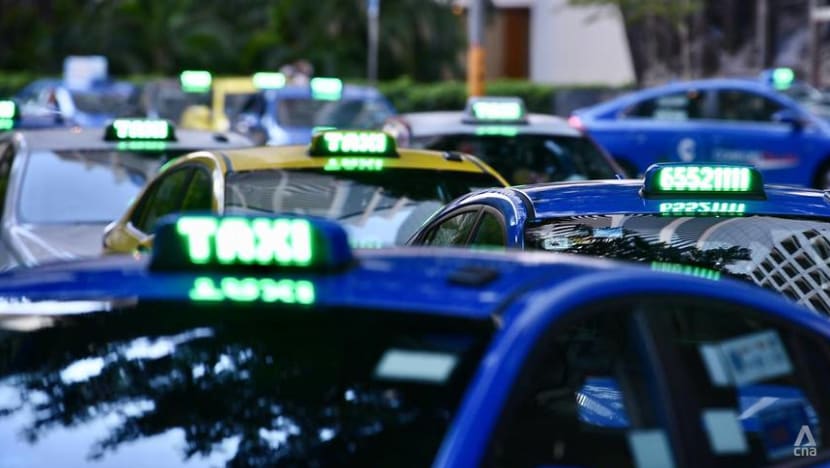Taxi operators can convert used cars into taxis in move to level playing field with private-hire cars
Used cars that are less than 5 years old can be converted into taxis, subject to the Land Transport Authority's approval.

Taxis wait in line along Battery Road during the evening peak hour in the central business district of Singapore on Jun 2, 2020 - the first day of Phase 1 post-circuit breaker. (Photo: CNA/Jeremy Long)

This audio is generated by an AI tool.
SINGAPORE: Taxi operators will have greater flexibility in managing their fleets, with new regulations allowing them to convert used cars that are less than five years old into taxis, said Senior Minister of State for Transport Amy Khor on Wednesday (Mar 5).
The change, announced in parliament as part of the Ministry of Transport’s (MOT’s) spending plans for the year, gives operators an additional option to expand their fleet, which may help reduce costs, Dr Khor said.
Operators who want to convert used cars to taxis will have to seek the Land Transport Authority's (LTA) approval.
This is one of the measures that the ministry is implementing to further level the playing field between taxis and private-hire cars (PHCs).
Taxi operators will also be allowed to resell taxis that are more than three years old, up to 5 per cent of their fleet. This move aims to reduce operators' risk in trialling new taxi models, such as multi-purpose vehicles (MPVs), which are more expensive but better suited for commuters needing larger vehicles, said Dr Khor.
The 2 per cent annual cap on taxi fleet growth will also remain suspended, so that operators can continue expanding their fleets beyond 2 per cent a year. The cap, which was first implemented in 2013, has been suspended since 2021 to enable taxi operators to replenish their fleet following the pandemic.
The measures require time to operationalise, said LTA in a statement.
It will continue to consult taxi operators, the National Taxi Association, and the National Private Hire Vehicles Association on the implementation plans, and more details will be provided at a later date.
The taxi fleet has more than halved over the past decade, from around 28,700 taxis in 2014 to around 13,100 taxis in 2024, said LTA.
Compared to PHCs, taxis incur higher operating costs due to differences in the regulatory regimes, with taxis subject to more restrictions, translating to higher rental costs for taxi drivers, the authority added.
"These moves give taxi operators more flexibility to manage cost and grow their fleet," said Dr Khor. "They complement our moves in the PHC sector to further level the playing field between taxis and PHCs."
NEW POLICIES TO STABILISE PRIVATE-HIRE CAR SUPPLY
Measures will also be introduced to stabilise the supply of private-hire cars. With immediate effect, LTA will require the disclosure of a vehicle’s history for all newly registered, converted or transferred private-hire cars.
“The move will improve transparency in the resale market, and further encourage registration of such vehicles only for their intended purposes,” said Dr Khor.
The new rule applies to cars registered using Certificates of Entitlement (COEs) obtained from the ongoing COE bidding exercise ending Wednesday.
This policy comes after the introduction of a three-year lock-in period for business-owned chauffeured private-hire cars which took effect last month, to ensure that companies acquire such vehicles primarily for leasing to drivers providing ride-hail services.
LTA also announced plans to impose additional requirements on large ride-hail operators, including higher data disclosure obligations.
This is because large operators are “naturally better able to match drivers and commuters", said LTA.
"Therefore, large operators should bear greater responsibility to set market norms that continue to protect the interests of commuters and drivers."
The additional requirements will not curb the growth of operators, said Dr Khor.
"These responsibilities are to assure drivers and commuters that large operators will not implement practices that may directly or indirectly restrict drivers’ or commuters’ choice, such as imposing minimum trip requirements on drivers," she said.

MORE "P2P STOPS"
Nine frequently used taxi stops in the central business district will be converted to "P2P stops", in response to requests from PHC drivers and commuters, said Dr Khor.
These stops can be used as pick-up and drop-off points by both taxis and private-hire cars.
The nine stops will be converted progressively, said LTA, starting with stop E19 on Shenton Way outside OUE Downtown and E13 on Battery Road at Straits Trading Building.
"We will monitor the impact on road traffic and usage of the converted taxi stops before deciding if this could be expanded to other taxi stops," said Dr Khor.
Taxi stands will remain exclusive to taxis, so that they can continue serving street-hail commuters.
LTA will also launch a P2P Inclusivity Co-funding Grant, aimed at helping operators develop solutions to improve accessibility to their services. This is to address issues such as seniors finding it difficult to navigate ride-hail applications, said LTA.
NO PLANS FOR SEPARATE PRIVATE-HIRE CARS COE
There are also no plans to create a separate certificate of entitlement (COE) category for business-owned PHCs, said Dr Khor.
For one, the bulk of the demand for Cat A and B COEs has been from local individuals and not from PHC or car leasing companies, and in the second bidding exercise in February, business-owned PHCs made up 6 per cent and 8 per cent of successful Cat A and B bids respectively.
The demand for PHCs also varies from quarter to quarter, given that fares and driver supply are highly responsive to commuter demand.
"It is very difficult to accurately determine the COE quota supply for PHCs that is required to meet the needs of drivers and commuters," she said.
"Therefore, the allocation between PHCs and private cars is best left to the market."
LTA will continue increasing the COE quota every quarter for Categories A, B and C until the supply peak from 2026, by using the cut-and-fill method and the injection of up to 20,000 new COE quota, she added.
















